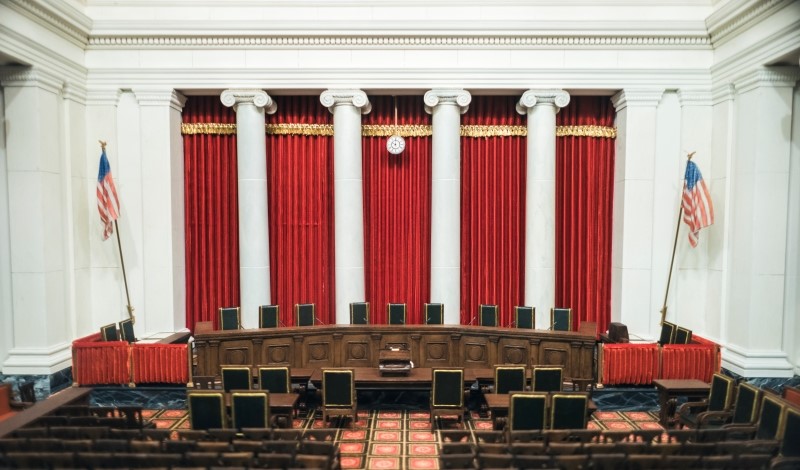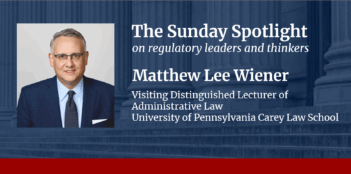
Recent Supreme Court rulings create the need to insulate administrative decisions from judicial review.
It is a great time to be a federal judge. At the most recent Federalist Society conference, a pair of federal judges raised glasses of champagne to celebrate a series of recent U.S. Supreme Court rulings that shifted state power away from federal agencies and toward the judiciary. One might say that the era of the administrative state has given way to a “juristocratic” state in which judges dominate the rest of our government.
If President Donald J. Trump’s judicial appointments in his second term are as hostile to agency power as those of his first—including those who raised a glass at the Federalist Society conference—the judicial power grab may be far from over. Opportunities to reassert agency authority may be few and far between in the near future. Even so, believers in effective regulation should use this time out of power to develop ideas to “court-proof” the administrative state. We should develop regulatory tools and strategies that restrain, evade, or are more durable against judicial review.
Liberals and progressives may believe that the solution to judicial overreach is comprehensive court reform. That may indeed be the best answer. However, restricting the anti-juristocracy agenda to only one branch needlessly limits reformers’ options—especially where there may be opportunities for piecemeal legislation with lower political stakes. In fact, thinkers from across the ideological spectrum may be in favor of some court-proofing ideas, particularly where they require Congress to legislate with greater precision.
Although this is far from an exhaustive list, here are some examples of what court-proofing could look like.
Congress could include self-effectuating default provisions in statutes whenever it delegated rulemaking authority. This would change anti-regulatory judges’ and litigants’ strategic trade-offs—instead of picking between issuing a rule or not, they would need to decide whether they would rather live with the regulation or the statutory default. Where the default is undesirable, either because it is more onerous to comply with or there are aspects of the rule potential plaintiffs want to keep, they may decide they would rather live with the rule. In addition, this would provide agencies some strategic latitude to decide whether to argue that aspects of their rule are severable from others. This structure would function similarly to what professors Cary Coglianese, Gabriel Sheffler, and Daniel E. Walters have called “unrules”—rules in which an agency exercises statutory authority to create exemptions or make other adjustments to statutory schemes.
Another legislative court-proofing strategy would be for Congress to add specific standards of review in particular statutes that are narrower than arbitrary and capricious review under Section 706 of the Administrative Procedure Act. If standards of review were more proscribed, agencies could more easily assess the risks of any regulatory proposal and address legal infirmities. Relatedly, Congress could codify agency- and statute-specific forms of deference, delegate the authority to define terms to agencies, and commit more decisions to agency discretion. Senator Elizabeth Warren (D-Mass.) has proposed codifying Chevron deference. As opportunities arise, however, Congress may find it easier to entrust specific agencies with more precise degrees of deference. In Loper Bright Enterprises v. Raimondo, in which the Supreme Court overturned Chevron deference, the Court accounted for the possibility of express delegations of the powers to define terms and to “fill up the details” of a statute. Congress should take the Court’s drafting advice.
Congress could also create additional barriers to forum-shopping. The U.S. Court of Appeals for the Fifth Circuit has become the favorite forum for pursuing an anti-regulatory agenda. Despite the fact that it covers only three states, the Fifth Circuit wields tremendous influence over almost every realm of national policy. It has blown holes in regulatory regimes such as long-standing drug approvals and anti-money laundering controls. As Hassan Ali Kanu notes in the American Prospect, the U.S. Chamber of Commerce has filed 63 percent of its lawsuits in the Fifth Circuit. Demonstrating its value to conservative legal activists, a group of Senate Republicans encouraged chief district court judges to ignore a recent policy change by the Judicial Conference of the United States that sought to curb forum-shopping.
There are ways to limit the power of the Fifth Circuit—or any other jurisdiction—over the national regulatory agenda. For example, Adam J. White has proposed that Congress create a framework by which it assigns cases involving nationwide injunctions by random lottery to any one of the federal district courts. In addition, Congress could heed the long-standing recommendation of the Administrative Conference of the United States to skip district court-level review for most agency rules, which would limit opportunities for forum shopping and settle legal questions more quickly. Finally, Congress could limit the scope of potential plaintiffs by paring back associational standing—particularly for trade groups—which is an important vehicle for regulated industries to challenge rules and shop for judges. As Michael T. Morley and Andrew Hessick explain in a recent article, associational standing is an under-scrutinized and a largely unnecessary deviation from Article III injury-in-fact requirements.
Moving away from legislative court-proofing, regulators could rely more heavily on agencies’ informational powers—the ability to gather information, research, and inform the public about pressing problems. The “sunshine” approach to regulation, as it is sometimes known, is a long-standing feature of the American scene. This approach calls the public’s attention to important issues and prompts states or the federal government to regulate. As Thomas McCraw describes in his Pulitzer Prize-winning classic, Prophets of Regulation, the 1869 legislation that created the Massachusetts Railroad Commission “focused not on the agency’s authority to issue orders but on the investigatory function,” and reserved its strongest language for provisions requiring corporations to hand over information requested by the Commission. Today, some federal agencies have similar information-gathering powers that are not tied to investigating violations of the law by specific entities. For example, the Federal Trade Commission (FTC) has the power to order companies to provide reports under Section 6(b) of the FTC Act. Similarly, the Consumer Financial Protection Bureau is required to monitor markets for consumer financial products and services under Section 1022(c) of the Dodd-Frank Wall Street Reform and Consumer Protection Act and produce at least one report per year on its findings.
In addition, agencies could be more aggressive about educating the public about their missions and working with journalists to do so. Some federal agencies were created after journalists revealed pressing public problems: Upton Sinclair’s The Jungle played a critical role in the creation of the Food and Drug Administration, and Rachel Carson’s Silent Spring set in motion the creation of the Environmental Protection Agency. Although some agency leaders, such as FTC Chair Lina Khan, are very adept at working with national media to explain and build support for the FTC’s work, few, if any, agencies, emphasize communicating with local media. Agencies with regional offices may be especially well positioned to reach local news and explain how their work benefits local communities and impacts their daily lives.
Finally, regulators could adopt a “cooperative federalism” approach to state-level regulation. As professor Adam Zimmerman describes in his recent article, “Ghostwriting Federalism,” federal agencies often assist state policymakers by commenting on proposed legislation, providing technical assistance with drafting, or even developing model laws. This kind of technical assistance could be especially useful in fields such as environmental law where state law is frequently modeled on, incorporates by reference, or otherwise relates to provisions of federal law.
Opportunities to implement court-proofing ideas and protect our government from rogue judges may be fleeting in the next few years. Even so, believers in effective regulation should be ready to make the most of those opportunities when they arise. Now is the time to get ready.




